From the Sperry Gardens: May 19, 2016
I grew up in College Station. You didn’t have to go very far south or east of town to find Spanish moss growing natively. And you didn’t have to go very far west of town to find ball moss growing natively. Both of those are Tillandsias, epiphytic (grow suspended in trees and on power lines, etc.) bromeliads. And I was quite familiar with the fact that pineapples are the most recognized bromeliad in the world. But that’s about where it ended for me.
I started at Texas A&M in summer 1962, and that was the first time I had ever seen fancy bromeliads being used as decorative plants inside a building. I liked them, and I grew a few of them, but over the years they never really tickled my fancy. (Translate: I never went really nuts over them.)
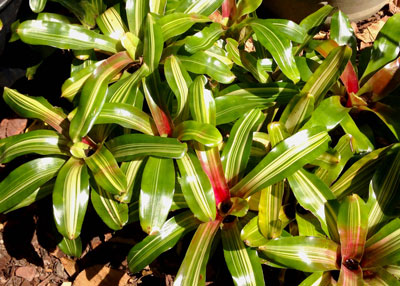
This was a single plant I bought 8 or 10 years ago. It now fills several pots.
But somewhere along the way, probably 20 years ago, I bought a small type of Neoregelia. That’s one genus within the huge bromeliad family. It turned out to be “rhizomatous,” meaning that it sprawls by sending out side shoots that develop into clumps of additional plants. One plant soon became many.
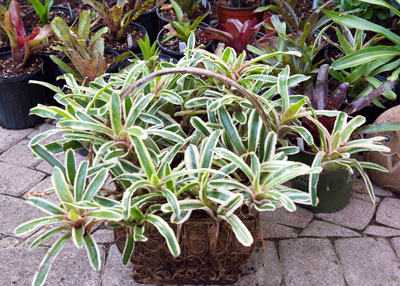
This is another spreading Neo that I bought. I believe I found three 4-inch pots at a cactus and succulent sale. I potted them into this rustic old wire basket.
And then I bought another one. And one more.
Now I have maybe 200, and the last 195 all came from eBay. I used the simple search “Neoregelia rhizomatous.” You have to keep the “Neoregelia” singular, because you’re looking for posts for one plant at a time.
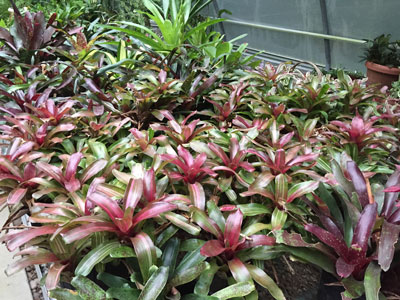
This is half of one of my greenhouse benches of assorted bromeliads. When I say “gone nuts over bromeliads,” this is what I mean.
A few of my plants came from Florida, and several were from Puerto Rico, but the biggest number by far came from Mark Hertz in New Orleans. (http://mabromeliads.com) Once you’re finished reading e-gardens, click into his website. Scroll halfway down and click into his “Listings on eBay” (900 different plants at the time that I’m writing this early this week). I ended up buying exclusively from Mark because of his incredible selection and fabulous quality.
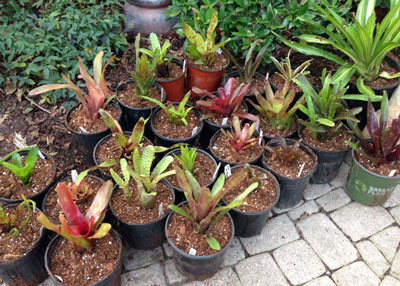
These plants had just arrived the afternoon before. We had them all potted by noon.
And
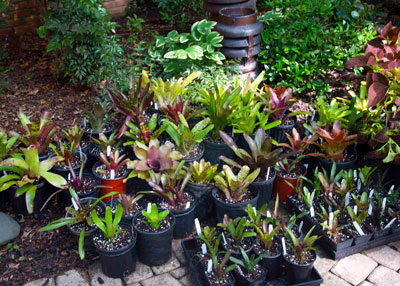
This is another shipment of plants – potted, watered and allowed to establish for several weeks.
So now it’s time to tell you why I was acquiring all these Neoregelias. It began with a trip to Hawaii on our 45th wedding anniversary. Along the Kona Coast I saw a landscape that was filled with bromeliads, sanseverias, ti plants and a host of other tropicals. While I couldn’t grow my bromeliads in the ground, I realized I could replicate the look by digging holes and hiding the pots in them. Then, when winter came, I’d just have to lift the plants out pot and all and take them back to the greenhouse.

This tropical garden grows within a mile of the Pacific Ocean on the Kona Coast on the Big Island, Hawaii.
Four summers ago I plunged a dozen of my big pots down flush with the soil. They made a summer-long bed of color, and most impressive of all, the armadillos left them alone. They got sun in the morning and shade all afternoon long, and they loved it.
Those plants I got from Mark one and two years ago have grown and filled in. They’ll color up with the bright mornings of summer. But they’re already handsome, and at the latest convention of North Texas armadillos, the word was out that Sperry’s landscape (at least the bromeliad part of it) was off limits.
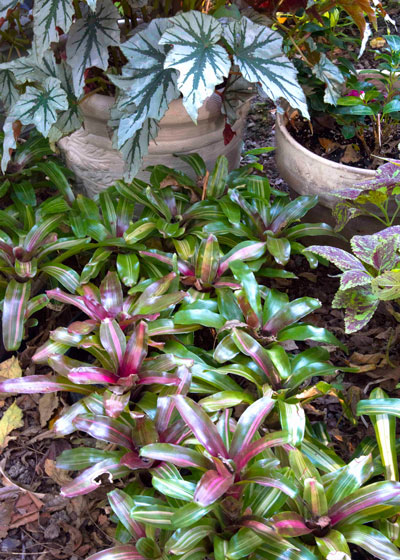
No armadillos allowed here! Bromeliads offer a nice change from conventional color plants in the Sperry home gardens.
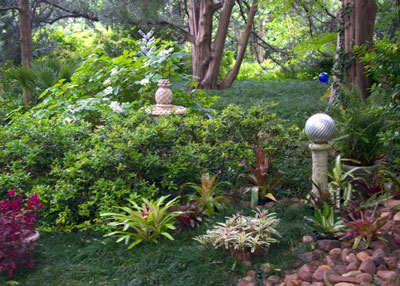
Finally, one corner of our gardens where I’m featuring bromeliads this year. Photo was taken two evenings ago, and it’s almost exclusively Neoregelias. (Bloodleaf Iresine, not a bromeliad, on far left.) Click for a larger view of the photo.
